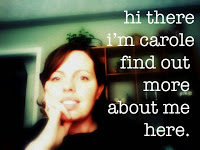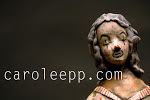by Carole Epp | Jan 19, 2012 | Uncategorized
Friday Afternoon Workshops
1:00 – 4:00 pm
Space is Limited. Pre-registration is required
Call to register 505-984-1122
Tuition: $50 per workshop
|
|
January 27
Studio Glazing Basics with Birdie Boone
Birdie Boone, SFC’s Studio Manager, leads this short workshop about how to use Santa Fe Clay’s studio glazes for cone 10 reduction. Wax resist? 3 count dip? Glaze tongs? If any of these sound foreign, then you will benefit from this informative workshop. Glazing demonstrations and discussions will be geared toward developing simple, successful glazing practices. Birdie will also provide information about the properties of each studio glaze that will help inform your glazing decisions and improve glaze fired results. |
February 3
Tin Foil Saggar Firing with Lee Akins 
Tin foil sagger is a low-fire process for achieving a mottled decorative finish. It is similar to pit firing and sagger firing with more predictable results. We will prepare and load our bisque pieces for firing in the gas kiln. Bring 4-5 bisque fired pieces. Applying terra sigillata before bisque helps in color development.
|
|
February 10
Speed Coiling with Avra Leodas  Come learn quick building methods for making large, asymmetrical, or even double-walled pieces. Coiling can be used in conjunction with other construction methods like slab building, or used on its own to increase scale and create interesting forms. |
February 17
Laser Print Decals with Maggie Beyeler
This workshop will demonstrate easy decal application to any glazed surface. Students will learn how to choose images that work well, and how to print these images onto decal paper utilizing a laser printer. Maggie will show how to best to apply decals, how to fire them, plus lots of tips and tricks. Students will need to bring finished, glazed pieces to work with. Flat surfaces work best, such as open bowls, plates or tiles, but any glazed surface can be used.
|
|
February 24
Introduction to Electric Kiln with Birdie Boone
This workshop is an introduction to how to load and fire a computerized electric kiln for both bisque and glaze firings. Most kilns come with a manual, but there is a lot more to know than which buttons to push. Birdie will demonstrate and discuss how to load and fire bisqueware and also how to load and fire glazeware for low, mid-range and high fire temperatures. This is a great workshop for anyone who has a kiln in a home studio or for anyone who wants to know more about the process. No actual firings will occur.
|
The raku workshops are designed to be taken individually or as a series.
Bring 4-5 bisque pieces for each week. Groggy stoneware (Soldate, Laguna Sculpture or Big White) works best.
March 23
 Raku Mini Marathon 1 with Lee Akins
This class will cover the basics of glazing and firing raku.
April 20
Raku Mini-Marathon 2 with Lee Akins
This class will explore slip resist and halo stain.
May 18
Raku Mini-Marathon 3 with Lee Akins
This class will learn about reducing with alcohol for copper matte glazes and spraying iron chloride with horsehair smoking.
|
|
April 6
Elements of Design with Cindy Gutierrez

Like words, pots have the ability to communicate; the trick is to understand what we want them to say, and then to figure out how we will have them reveal this. As we create, every design choice we make affects the finished piece. In this workshop we will explore what these choices may be, when to make them, and why. We will touch upon the practice of looking at pots with an eye not only for function, but also toward personal styles and goals. All this in an effort to better understand our process, and to challenge our way of seeing and deciding on what is in this pot.
|
|
April 13
Studio Glazing Basics with Birdie Boone
 This short workshop will address how to use Santa Fe Clay’s studio glazes for cone 10 reduction. Glazing demonstrations and discussions will be geared toward developing simple, successful glazing practices. Birdie will also provide information about the properties of each studio glaze that will help inform your glazing decisions and improve glaze fired results. |
 Weekend Workshops Weekend Workshops |
EXTRUDERMANIA!
Nathan Craven
|
FREAKS, GEEKS, MISCREANTS and  SUPERHEROES: PUTTING A LITTLE ALTER – EGO INTO CLAY Kevin Snipes Saturday & Sunday, March 10 & 11 SUPERHEROES: PUTTING A LITTLE ALTER – EGO INTO CLAY Kevin Snipes Saturday & Sunday, March 10 & 11
9:30 am – 4:30 pm class description> |
CERAMIC MOLDS for SLUMPING GLASS  Shel Neymark Saturday & Sunday, May 19 & 20 9:30 am – 4:30 pm class description> Shel Neymark Saturday & Sunday, May 19 & 20 9:30 am – 4:30 pm class description> |
545 Camino de la Familia
Santa Fe, NM 87501
505-984-1122
by Carole Epp | Jan 19, 2012 | Uncategorized

A broad survey of more than fifty ceramic artists who worked in the Los Angeles Area in the decades following World War II, Common Ground, as a book and exhibition, celebrates the art that is central to the mission of the American Museum of Ceramic Art in Pomona, CA. The artists selected for Common Ground all had a direct connection to Millard Sheets, an artist, art educator, arts administrator, and designer, whose activities and ideology had an enormous impact on southern California in the middle of the twentieth century. The essays take different perspectives on the region’s dynamics, together presenting an in-depth analysis of the complex and diverse factors that created a fertile ground for ceramics. Elaine Levin introduces the major figures in ceramics from the 1920s through the postwar years and outlines Southern California’s ceramic history and aesthetics. Harold B. Nelson sketches a biographical portrait of Millard Sheets that shows the artist and administrator’s multifaceted roles. Christy Johnson recounts the story of a little-known potter, Marian Moule, that illuminates the broader experiences of the student and aspiring ceramist in the 1950s and 1960s. Jo Lauria describes new avenues to show and sell – craft competitions, interior design showrooms, and art fairs – and illustrates successful marketing tactics with case studies. Dr. Billie P. Sessions chronicles the evolution of college-level ceramic education and compiled an appendix of Southern California colleges, instructors and students. James F. Elliot-Bishop provides a chronology of Gladding, McBean, an early innovator of ceramic technology, that evolves through mergers into Interpace, a company that employs ceramicists to design dinnerware for commercial production and produce original tile murals. Dr. Cecile Whiting surveys the broader Los Angeles art scene, offering a balanced and scholarly analysis of the trends that persisted and the new artists who emerged by the 1970s. From the 1950s through the 1970s crafts, especially ceramics, came to represent the free spirit of self-expression and experimentation that characterized west coast living. Common Ground: Ceramics in Southern California 1945-1975 tells the stories of a generation of studio potters, who were often self-taught or trained in traditional apprenticeships but helped develop college curricula for ceramics. They advanced the technology of the wheel and the kiln, developed glazes and techniques. By establishing professional organizations, such as the American Craft Council, and publishing craft-themed magazines including Craft Horizons and Ceramics Monthly, their expertise and experimentation were shared. Through their efforts. galleries and museums eventually recognized ceramics as a valid art medium. New theories and aesthetic philosophies were debated: the European, Bauhaus-grounded function-and-form school versus the Zen-influenced, abstract-expressionist artists; those who advocated clay as an aft-form and those who sought to make a living by incorporating ceramic design in industry and architecture. Eventually all found a place and added to the distinct ethos of high and low art, nature and technology that defined southern California culture.To purchase a copy visit The American Museum of Ceramic Art website.
by Carole Epp | Jan 19, 2012 | call for entry, emerging artist, job posting, monday morning eye candy, movie day, residency opportunity, show us your influences, technical tuesday

The Noosa Regional Gallery , Sunshine Coast Art Prize 3D (SCAP 3D) is presented by the Friends Noosa Regional Gallery Inc. The non- acquisitive Art Prize includes $15,000 + a four-weeks arts residency on the Sunshine Coast valued at $5,000. A non-acquisitive Highly Commended Prize of $2,500 will also be announced at the launch. A non-acquisitive People’s Choice Prize to the value of $2,500 will be announced 1 week prior conclusion of the exhibition. Artists will be selected from entries submitted to the Pre-selection Panel. Works will be selected from photographs submitted with the entry. Any Australian Citizen working in Australia in any 3D medium may enter. The Pre-selection Panel will invite up to 40 artists to exhibit one work in the SCAP 3D exhibition. The Judge will select the winner and highly commended artist from the 40 finalists.Applications need to be received by 31 March 2012.
Mail applications to: Noosa Regional Gallery, Sunshine Coast Art Prize 3D, Locked Bag 72, Sunshine Coast Mail Centre QLD 4560
Please visit their website for all the details.
If further information is required please: Contact
Noosa Regional Gallery, SCAP 3D [email protected] Exhibition Officer
Nicole Maggs
Ph: 07 5449 5376
e-mail: [email protected] Exhibitions Manager
Nina Shadforth
Ph: 07 5449 5397
e-mail: [email protected]
by Carole Epp | Jan 18, 2012 | Uncategorized
Today the colors of musing have been darkened to black protesting against SOPA and PIPA.
To learn more please visit wikipedia.
by Carole Epp | Jan 18, 2012 | Uncategorized
A unique opportunity to gain in-depth knowledge of the museum sector. Future curators is a unique and exciting project which offers trainees the opportunity to spend a total of 18 months at two UK museums where they gain in-depth knowledge of the museum sector and an accredited diploma in curatorship. The British Museum and five partner museums are looking for five creative individuals to take part in this work-based training initiative. Future curators is generously funded by the HLF Skills for the Future programme.
Apply for a traineeship in these fields:
Ancient Egypt and Sudan Ethnographic collections Far eastern culture Islamic art and culture Late medieval Europe
Closing date for applications Friday 17 February 2012, 12.00Find all the details
here.





 Raku Mini Marathon 1 with Lee Akins
Raku Mini Marathon 1 with Lee Akins
 This short workshop will address how to use Santa Fe Clay’s studio glazes for cone 10 reduction. Glazing demonstrations and discussions will be geared toward developing simple, successful glazing practices. Birdie will also provide information about the properties of each studio glaze that will help inform your glazing decisions and improve glaze fired results.
This short workshop will address how to use Santa Fe Clay’s studio glazes for cone 10 reduction. Glazing demonstrations and discussions will be geared toward developing simple, successful glazing practices. Birdie will also provide information about the properties of each studio glaze that will help inform your glazing decisions and improve glaze fired results. Weekend Workshops
Weekend Workshops
 SUPERHEROES: PUTTING A LITTLE ALTER – EGO INTO CLAY Kevin Snipes Saturday & Sunday, March 10 & 11
SUPERHEROES: PUTTING A LITTLE ALTER – EGO INTO CLAY Kevin Snipes Saturday & Sunday, March 10 & 11 Shel Neymark Saturday & Sunday, May 19 & 20 9:30 am – 4:30 pm class description>
Shel Neymark Saturday & Sunday, May 19 & 20 9:30 am – 4:30 pm class description> 









